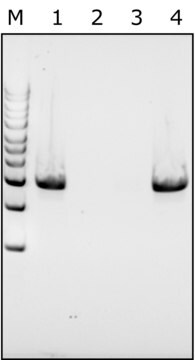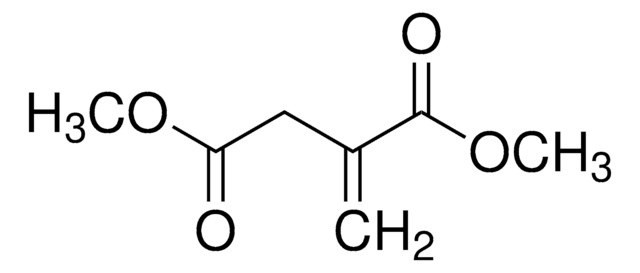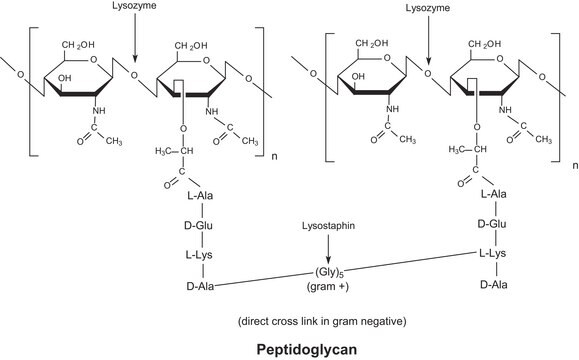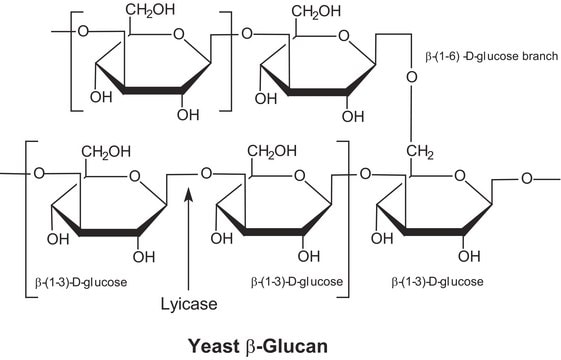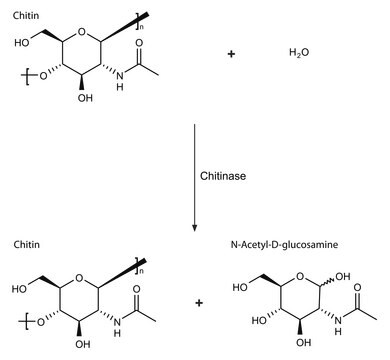SAE0091
Lysostaphin from Staphylococcus staphylolyticus
free of DNA contaminants, ≥500 units/mg protein, lyophilized powder, suitable for Microbiome research
동의어(들):
Lysostaphin from Staphylococcus staphylolyticus, Glycyl-glycine Endopeptidase
로그인조직 및 계약 가격 보기
모든 사진(2)
About This Item
CAS Number:
MDL number:
UNSPSC 코드:
12352202
NACRES:
NA.54
추천 제품
제품명
Lysostaphin from Staphylococcus staphylolyticus, free of DNA contaminants, suitable for Microbiome research, lyophilized powder, ≥500 units/mg protein
생물학적 소스
microbial (Staphylococcus staphylotyticus)
양식
lyophilized powder
특이 활성도
≥500 units/mg protein
분자량
27 kDa
특징
DNA free
배송 상태
wet ice
저장 온도
−20°C
유사한 제품을 찾으십니까? 방문 제품 비교 안내
애플리케이션
Purified extracellular lysostaphin from S. staphylolyticus SAE0091 undergoes strict quality control testing to ensure the absence of detectable levels of contaminating DNA using 35 cycles PCR amplification of 16S and 18S rDNA using universal primer sets.
Lysostaphin is a zinc metalloenzyme isolated from a bacterial culture of Staphylococcus staphylolyticus. It has specific lytic action against other Staphylococcus species, including S. aureus.1,2 Lysostaphin has
hexosaminidase, amidase, and endopeptidase activities. It cleaves polyglycine crosslinks in the cellular wall which leads to cell lysis of Staphylococcus species, but not of other bacterial genera. [Pharmaceuticals 2010, 3(4), 1139-1161]
Lysostaphin is a single polypeptide chain of 246 amino acids, a molecular mass of 26,926 Da, isoelectric point of 9.5, (5) and an activity pH optimum of 7.5.(6)
Lysostaphin is a zinc metalloenzyme isolated from a bacterial culture of Staphylococcus staphylolyticus. It has specific lytic action against other Staphylococcus species, including S. aureus.1,2 Lysostaphin has
hexosaminidase, amidase, and endopeptidase activities. It cleaves polyglycine crosslinks in the cellular wall which leads to cell lysis of Staphylococcus species, but not of other bacterial genera. [Pharmaceuticals 2010, 3(4), 1139-1161]
Lysostaphin is a single polypeptide chain of 246 amino acids, a molecular mass of 26,926 Da, isoelectric point of 9.5, (5) and an activity pH optimum of 7.5.(6)
생화학적/생리학적 작용
Lysostaphin is a zinc endopeptidase with a molecular weight of approximately 25 kDa. Because lysostaphin cleaves the polyglycine cross-links in the peptidoglycan layer of the cell wall of Staphylococcus species it has been found useful for cell lysis and also as a potential anti-microbial therapeutic.
pH Optimum for activity: ~7.5
pH Optimum for activity: ~7.5
Lysostaphin is a zinc endopeptidase with a molecular weight of approximately 25 kDa. Because lysostaphin cleaves the polyglycine cross-links in the peptidoglycan layer of the cell wall of Staphylococcus species it has been found useful for cell lysis and also as a potential anti-microbial therapeutic. pH Optimum for activity: ~7.5.
단위 정의
One unit will reduce the turbidity (A620) of a suspension of Staphylococcus aureus cells from 0.250 to 0.125 in 10 min at pH 7.5 at 37°C in a 6.0 ml reaction mixture.
물리적 형태
Supplied as a lyophilized powder containing 50–70% protein with the balance primarily as NaCl.
신호어
Danger
유해 및 위험 성명서
예방조치 성명서
Hazard Classifications
Resp. Sens. 1
Storage Class Code
11 - Combustible Solids
WGK
WGK 3
Flash Point (°F)
Not applicable
Flash Point (°C)
Not applicable
가장 최신 버전 중 하나를 선택하세요:
이미 열람한 고객
Judy J J Ou et al.
Frontiers in cellular and infection microbiology, 6, 187-187 (2017-01-14)
Background:Staphylococcus aureus (S. aureus) small colony variants (SCVs) can survive within the host intracellular milieu and are associated with chronic relapsing infections. However, it is unknown whether host invasion rates and immune responses differ between SCVs and their wild-type counterparts.
Caroline Meyer Olesen et al.
Microorganisms, 9(7) (2021-08-08)
Investigation of changes in the skin microbiome following treatment of atopic dermatitis (AD) with dupilumab may provide valuable insights into the skin microbiome as a therapeutic target. The aim of this study is to assess changes in the AD skin
Ing-Marie Jonsson et al.
PloS one, 5(12), e14209-e14209 (2010-12-15)
Ecs is an ATP-binding cassette (ABC) transporter present in aerobic and facultative anaerobic gram-positive Firmicutes. Inactivation of Bacillus subtilis Ecs causes pleiotropic changes in the bacterial phenotype including inhibition of intramembrane proteolysis. The molecule(s) transported by Ecs is (are) still
Jianjun Miao et al.
Biomaterials, 32(36), 9557-9567 (2011-10-01)
With the emergence of "super bacteria" that are resistant to antibiotics, e.g., methicillin-resistant Staphylococcus aureus, novel antimicrobial therapies are needed to prevent associated hospitalizations and deaths. Bacteriophages and bacteria use cell lytic enzymes to kill host or competing bacteria, respectively
T Baba et al.
The EMBO journal, 15(18), 4789-4797 (1996-09-16)
Microbial organisms secrete antibiotics that cause the selective destruction of specific target cells. Although the mode of action is known for many antibiotics, the mechanisms by which these molecules are directed specifically to their target cells hitherto have not been
자사의 과학자팀은 생명 과학, 재료 과학, 화학 합성, 크로마토그래피, 분석 및 기타 많은 영역을 포함한 모든 과학 분야에 경험이 있습니다..
고객지원팀으로 연락바랍니다.

